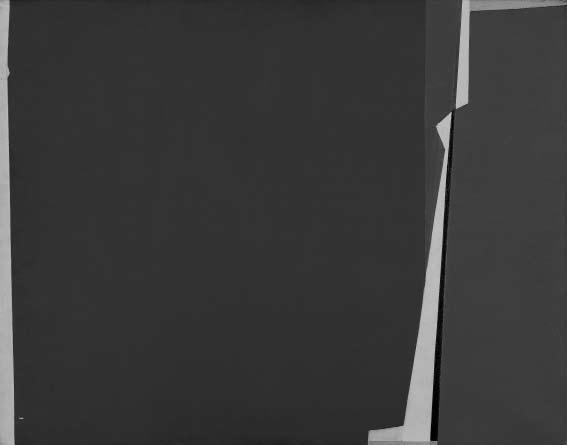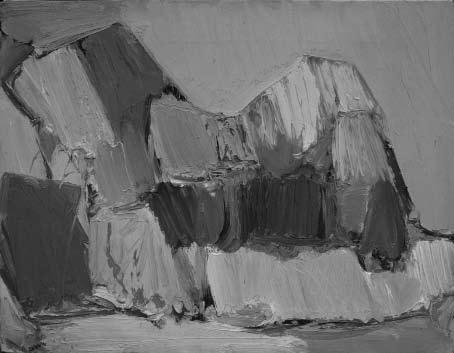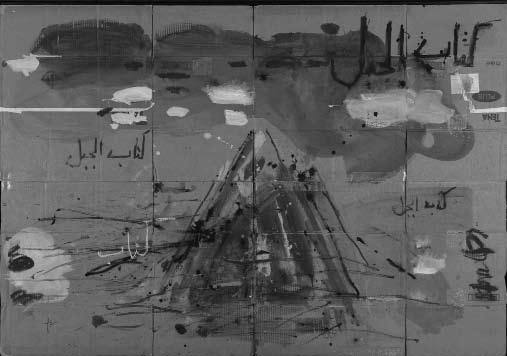
Beirut
Landscapes. Cityscapes. 1
Maqam Art Gallery
February 3—March 30, 2009
Debates about what constitutes modern or contemporary art might seem like the purview of academics or auction house specialists. Yet the question has suddenly become a preoccupation for many involved in the Beirut art scene — symptomatic, no doubt, of a system under strain. The need to delineate and define may in general be no more than the articulation of market pressure. In Lebanon, it may also be the latest in a long line of somewhat tiresome expressions of the country’s pervasive sense of existential dread. Whatever the case may be, a recent show at the newly opened Maqam Art Gallery seemed to capture the spirit of the current, curiously discursive moment in this city’s art world.
In early 2009, Saleh Barakat, the owner and director of Agial Art Gallery in Hamra, teamed up with the veteran art critic Joseph Tarrab to open Maqam, a gallery in downtown Beirut’s Saifi Village, dedicated to restoring and reviving the history of Lebanese modern art. The loose brackets around what the gallery intends to show (and sell) open with the mid-nineteenth century and close with the mid-twentieth. But the first exhibition nudged things a bit closer to the present. ‘Landscapes. Cityscapes. 1’ presented thirty works from 1930 to 2008.
The show was revelatory in several ways. Opportunities to see in person canvases by the likes of Chafic Abboud, Cesar Gemayel, Omar Onsi, Georges Corm, Saliba Douaihy, and Mustafa Farroukh are rare, particularly in a city that doesn’t have a museum or public institution working to preserve and present to the public any cultural heritage after antiquity. Unless you can bully your way into the salons of collectors or the back rooms of dealers, the only chance to see this stuff is by browsing books, volumes often out of print or haphazardly produced. And no paper reproduction could accurately represent Onsi’s ability to capture late-afternoon Levantine light, or the material texture of Paul Guiragossian’s thick, swirling brushstrokes.

What made ‘Landscapes. Cityscapes. 1’ more than a recent-history lesson, however, was the story the show told. From a precious, circa-1930 painting of a winsome pine tree by Youssef Howayek (who was far better known as a sculptor) to a melancholy, rain-drenched black and white photograph from 1999 by Fouad Elkoury, of Beirut’s seaside Corniche, the exhibition explored how artists in Lebanon have depicted the world around them through eight tumultuous decades, from easel painting to impressionism and abstract expressionism, from landscape painting as a realist exercise to depictions that are imaginative metaphors for an artist’s mind. There were pictures of pristine forests and lush agricultural lands. There was a powerful painting by Rafic Charaf, of Baalbeck under storm-heavy skies, from 1962, full of foreboding for what was to come. And then there was a raucous, graffiti-style painting on cardboard by the famously reclusive Samir Khaddage, and a three-piece series by Marwan Rechmaoui, made from concrete, wire mesh, and Plexiglas. Were these works modern or contemporary or hovering somewhere in between? If chronologies, definitions, or linear histories were to be believed, then what was one to make of the 2008 paintings by Rima Amyuni and Theo Mansour, the styles and aesthetics of which seemed to belong to an era that ended fifty years or more ago? (Amyuni’s canvas, notably, was titled Homage to Van Gogh.)

Adherents to the kinds of conceptual practices that have been produced, presented, and promoted by organizations such as Ashkal Alwan and the Arab Image Foundation might have found the show either quaint or dangerous — in the latter case, an attempt to harness, reign in, or reinforce links and lineages that have been rather deliberately smashed. But the exhibition and the work of Maqam generally have contributed a great deal to the debates — about the inherent instability of history and memory — that have so dominated the works of contemporary artists Walid Raad, Akram Zaatari, Jalal Toufic, Walid Sadek, Rabih Mroué, and others. Though not every work was a knockout, the exhibition was of commendably high quality. If Maqam continues to mount such shows, it will encourage artists, critics, and curators to sharpen their language and hone their terms. Given the fact that every show at the gallery — Barakat and Tarrab say they plan to mount three or four exhibitions a year — is meant to be accompanied by a catalog, Maqam will also be contributing to the dire need for documentation, in Lebanon as in the region at large. It isn’t a museum, but it’s a step in that direction. And considering how the trajectories of modern and contemporary were, in fact, so tangled up in the show, ‘Landscapes. Cityscapes. 1’ at least demolished the idea that one era followed the other.